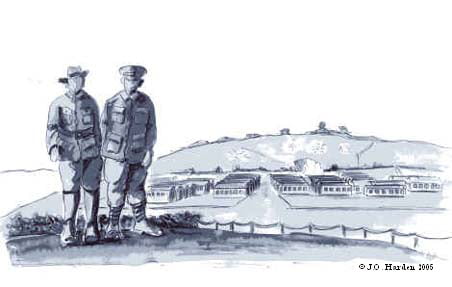
World War II
The World War of 1939–45 seems not to have affected Fovant on anything like the same scale as the upheaval caused by the Camps during the First World War. Reminiscences gathered from villagers who lived here during that period often start with the statement ‘well, nothing much happened’.
It is true that many young men of Fovant, and women this time, served in the Forces and thankfully the casualty list was nowhere near as heavy as that suffered in World War I. There was obviously much more aerial activity because of the advances in aviation and the not far distant airfields of Middle Wallop and Boscombe Down for example. Prisoners of War helped on the land, Italians this time as well as Germans and Land Girls also worked in agriculture and forestry.
The limestone caves of nearby Chilmark had been acquired by the Air Ministry in 1937 and served as an R.A.F. bomb store throughout the war, and indeed long afterwards, not closing until 1995. After the war the ‘gate guardian’ of R.A.F. Chilmark showed the range of its stores by mounting a small incendiary bomb on top of an example of Barnes Wallis’s 10 ton ‘Grand Slam’ bomb. Many residents of Fovant were employed by R.A.F. Chilmark and some Air Ministry houses were built in the village (at Leatler Close), serving as officers’ married quarters.
 The entry of the U.S.A. into the war brought a considerable influx of American servicemen into the area. Nearby Dinton Park served as the headquarters of the U.S. Army Air Forces Base Air Depot No. 4. and a site of large storage huts were built near the railway. As there were railways sidings already at Dinton serving R.A.F. Chilmark, this new location was christened the Baverstock site, even though it was a long way from Baverstock.
The entry of the U.S.A. into the war brought a considerable influx of American servicemen into the area. Nearby Dinton Park served as the headquarters of the U.S. Army Air Forces Base Air Depot No. 4. and a site of large storage huts were built near the railway. As there were railways sidings already at Dinton serving R.A.F. Chilmark, this new location was christened the Baverstock site, even though it was a long way from Baverstock.
The site was also near the river, so a considerable amount of hard core had to be dumped before the large huts (which are still there) could be built. Most of this came from the Mendips using its limestone, but some was chalk from Fovant. Residents who were children at the time remember being impressed by the amount of loaded trucks speeding through the village on their one-way circular route between Fovant Down, Dinton and Compton Chamberlayne.
Many soldiers, both American and British, used the rifle ranges re-established under Fovant Down. Some of their names, written on the wall of the butts whilst they marked and pasted the targets, are still there. These have revealed their homes, their units and the dates that they served.
 Whilst there was never the density of the WW I camps, isolated sites for searchlights and anti-aircraft guns were placed near to the village and on the Downs. There are memories of aircraft crashes in the area, but it is not known whether any of these guns were responsible. The only crash that we have documented so far was blamed by one of the escaping crew on sabotage by the French Resistance, as it had suffered a double engine failure. It occurred on the night of 16 March 1941 and its story, together with one of the aircraft’s propeller blades, is displayed in Dinton Village Hall.
Whilst there was never the density of the WW I camps, isolated sites for searchlights and anti-aircraft guns were placed near to the village and on the Downs. There are memories of aircraft crashes in the area, but it is not known whether any of these guns were responsible. The only crash that we have documented so far was blamed by one of the escaping crew on sabotage by the French Resistance, as it had suffered a double engine failure. It occurred on the night of 16 March 1941 and its story, together with one of the aircraft’s propeller blades, is displayed in Dinton Village Hall.
One organisation active throughout most of the war was the Home Guard. In the words of one of its members:
‘When in the early days of the Second World War, with the threat of invasion looming ever closer and nationwide units of Local Defence Volunteers were formed (later to become the Home Guard), a unit in Fovant was born and dedicated to defending the locality, come what may’
The comradeship lasted well after the war and resulted ulltimately in the formation of the Fovant Badges Society, as described in some of the previous pages.
Click on the links below to find more information on military activity in Fovant during the Second World War:
Graffiti recorded in a nearby rifle range
Details of the crash of a Ju88 0n the 16th March 1941 and it’s later excavation
M.C.L.H.
February 2004
Content last updated
29 November 2015

